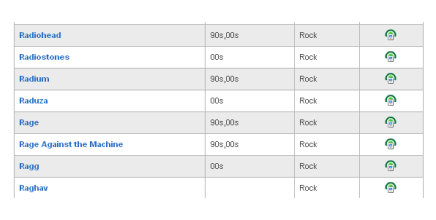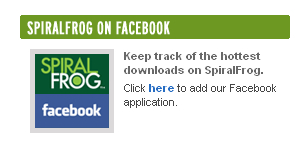A Conversation With Matthew Stern
Earlier this week I spoke with Matthew Stern, Vice President Marketing and PR for SpiralFrog. We talked about how the service operates, their target market, and quite a bit about the company's future plans. I was happy to hear that the issues I find most critical are being addressed already and the first improvements should be ready soon. But the most important thing I learned about SpiralFrog from Matthew wasn't about the technology, so much as the company's approach to potential and current members.
SpiralFrog's Target Market
Although as a free music service SpiralFrog could easily be focused on attracting any number of groups, they've wisely decided to concentrate on 13 - 17 year olds who are currently using P2P to download music. They're hoping to attract these teens, who clearly don't intend to pay for their music now, in the hope that an alternative to illegal, and potentially unsafe, downloading off P2P will appeal to them. This doesn't mean that they only have newer music, just that the service's look and feel have been designed to cater to that demographic.Royalty Payments
Unlike an online music store where the royalties are paid once per song (or album) at the time of purchase, SpiralFrog pays based on how often each song is played. In that respect it's more like radio. No doubt some people will find this attractive since it allows them to reward their favorite artists. While I have to admit this appeals to me, I'm not sure it's a workable scheme since it results in royalty payments over an indefinite period for a fixed amount of ad revenue.More Than Just Music
 SpiralFrog's ad-supported model means requiring that you spend a lot of time on their site to download music. Hoping to give members other reasons to visit they've added features like extensive information on artists, albums, and songs provided by All Music Guide, and recommendations for similar artists. They also have a large selection of music videos for streaming and download. I've watched a few on my SDTV (through Windows MCE) and found them to be of reasonably good quality. There are even links to buy the music you're downloading from Amazon.com.
SpiralFrog's ad-supported model means requiring that you spend a lot of time on their site to download music. Hoping to give members other reasons to visit they've added features like extensive information on artists, albums, and songs provided by All Music Guide, and recommendations for similar artists. They also have a large selection of music videos for streaming and download. I've watched a few on my SDTV (through Windows MCE) and found them to be of reasonably good quality. There are even links to buy the music you're downloading from Amazon.com.
One thing Matthew mentioned that I hadn't considered was the potential for SpiralFrog on college campuses. University networks are often managed to be as P2P unfriendly as possible, although the number of RIAA lawsuits from file sharing from college networks indicates that there's still plenty of P2P activity going on now. At some point though it becomes easier for a college student to simply obtain their free music legally rather than play cat and mouse with network administrators. The verdict is still out on when we'll reach that point.

Catalog Size
Music selection from SpiralFrog has increased by around 25% since their launch in September. I asked about the outlook for more expansion and was told the number of songs is expected to double within the next few months.One of their biggest coups as a startup company was acquiring the rights to offer Universal Music Group (UMG) owned tracks. UMG tracks represent a larger share of the world music market than any other single company. Although Matthew was vehement that SpiralFrog isn't intended to be competition for online music stores, and certainly not for iTunes, UMG's dissatisfaction with Apple's pricing structure has motivated them to branch out to distribute music in a variety of ways and through a variety of services.
How Viable Is It?
 There has been legitimate criticism of SpiralFrog's business model, but perhaps the most important thing I learned in my conversation with Mr. Stern was that ad-supported music is only one part of the company's plan. In order for the service to survive they'll need a reason for people to make a return visit more than once a month (currently required to renew the license for their music). That's where videos, shared playlists, and an array of music recommendations from a list of the most downloaded songs in the current week to the latest additions to SpiralFrog's catalog and what their staff is listening to come in. There's even an add-on to promote their downloads on your Facebook page.
There has been legitimate criticism of SpiralFrog's business model, but perhaps the most important thing I learned in my conversation with Mr. Stern was that ad-supported music is only one part of the company's plan. In order for the service to survive they'll need a reason for people to make a return visit more than once a month (currently required to renew the license for their music). That's where videos, shared playlists, and an array of music recommendations from a list of the most downloaded songs in the current week to the latest additions to SpiralFrog's catalog and what their staff is listening to come in. There's even an add-on to promote their downloads on your Facebook page.
Perhaps most importantly, there seems to be a genuine interest on the part of company executives to listen to visitors who tell them what they're looking for. The real revolution SpiralFrog represents isn't paying license fees through ad revenue. That's becoming more common for a variety of content every day. What still isn't being done by and large is simply asking the public what they want, and that seems to be what SpiralFrog is pinning their hopes on

